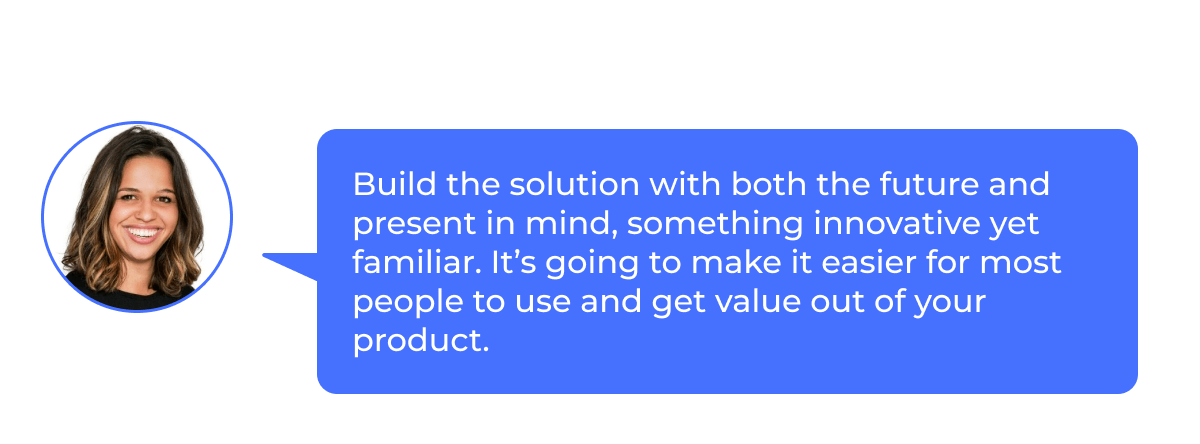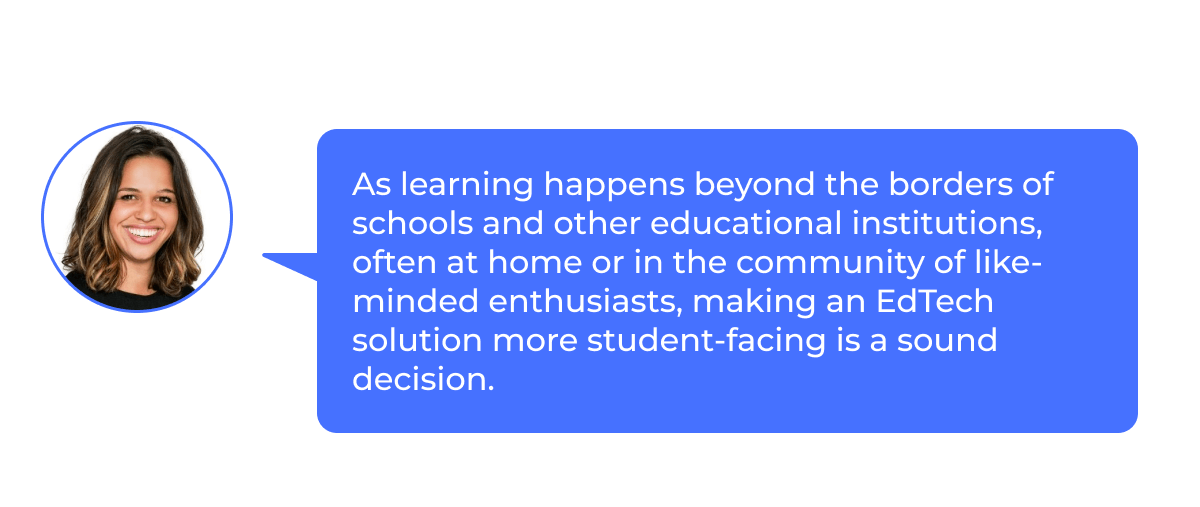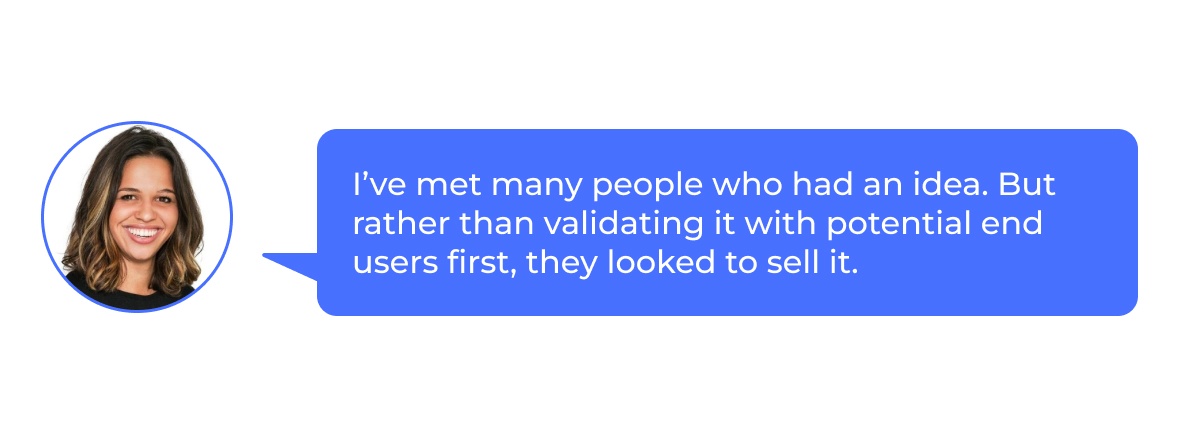Elyse And Oxagile’s Talk About The EdTech Domain
A formula for extracting valuable EdTech insights is as follows: the first variable is persona. It’s Elyse Burden, a Forbes 30 Under 30 person and Executive Director at Real World Scholars.
Second is partner. This is about Oxagile, a software development company collaborating with Elyse on a few eLearning projects. It has taken a step further by acting as a moderator over the course of the interview.
The third variable turned out to be synergy between the EdTech expert and custom software solutions provider, which let this tandem bring out some considerations powered by Elyse’s experience in the EdTech domain.
What does the world of EdTech breathe? If the time machine was real, what would Elyse do differently? Mobile vs. web eLearning: what’ll win? Is collaboration reaching a dead end if there are no questions along the way? Welcome to exploring EdTech together!
EdTech Today

What’s likely to be the most topical reasons for concern among EdTech players?
As for the K-12 space, the area I primarily work in, there are two major issues—privacy and technology adoption.
Privacy first—beyond technical regulations, there’s a lot of fear around what students can have access to. Local, state, and federal regulations can together be restrictive, and some schools choose to go beyond what’s required. This means that eLearning software solutions have to reconcile how they will abide by or work around privacy restrictions, like we did for student accounts within our EdTech platform.
Our way to confront one of the biggest issues—the common inability for students to receive external emails on school accounts, and specifically our invite emails—was to get rid of inviting users via emails. Instead, student accounts were created by teachers and came with a PIN they could use to log in.
Another EdTech challenge is technology adoption resistance, or innovation fatigue. As teachers often say that time is their most valuable and scarce resource, they sometimes express suspicion and hesitation dedicating too much time to getting acquainted with new tech.
How should education software development providers behave to combat teachers’ general reluctance to transform well-established approaches?
Intuitive innovation can help smooth over the situation and ease the onboarding process when it comes time for teachers to explore new technologies in their classroom.
When rebuilding our technology, we tried to make our software platform as easy as humanly possible. With earlier versions of our platform, we noticed that when teachers found processes or design complex, they were more likely to shut down and quietly exit through the back.
That’s why I resisted the temptation of building something complex and feature-rich. Focusing on teacher comfort and accessibility, we went another route and made the solution super easy, time-efficient, and familiar to other platforms they might have seen.
It had a menu along the side, like many of the app panels they have seen, which answered the question of, “Gosh, how should I get started?”
And this became my biggest takeaway—build the solution with both the future and present in mind, something innovative yet familiar. It’s going to make it easier for most people, especially those who are less comfortable with new technology, to use and get value out of your product.
Where are eLearning trends going to take us? Is mLearning ambitious enough to displace web?
While most people—young people and adults—consume content via mobile, it’s still a mixed bag in schools. Schools have varying policies—from Bring-Your-Own-Device to highly regulated Chromebooks that belong to the schools (and everything in between). In many places, students are not allowed to utilize their phones during classes.
Here comes a gap between in-system learning, where you have to accommodate school regulations, and out-of-system activities (like tutoring), which are accessible outside of school and can leverage mobile learning.
What about corporate learning?
I’d say that moving forward, corporations will probably focus on mobile because everyone else has moved in that direction. Still, some businesses are behind the trend, seeing a need to track their employees’ learning activities on work laptops. And because of that, software providers should hold both mobile and web-based solutions.
Project Highlights
Real World Scholars at a glance:
- A nonprofit organization supporting student-run businesses with tech and funding
- Since 2014, over 50,000 students have been engaged in real-world entrepreneurship.

What makes your project stand out?
We’re the only platform in the U.S., at least in the K-12 space, that allows students to run real businesses that make real money.
Although there are other programs teaching them how to pitch their ideas, even reach out to real investors, we’ve built a solution merging learning and real eCommerce.
What’s the role of software in this educational eCommerce ecosystem?
The EdCorps program is oriented towards classrooms and helps students and teachers start a business. While we provide various types of support for these businesses, the very core is an eCommerce dashboard.
About nine years ago, we found out that many teachers wanted to offer real-world entrepreneurial experiences to their students and/or thought about running a business with their students, but they didn’t have a proper mechanism to collect money, pay sales taxes, and process a great variety of other payment transactions.
Seeing this, we built an eCommerce dashboard that would allow any class to start their storefront and legally sell whatever they wanted, under our nonprofit umbrella. Today, we have about 90 active student-run businesses, with all money coming into one umbrella account. As all profits belong to them, we send their money back to the business when they ask for it, or “cash out.”
At first, our intention was limited to the software only. Then we learned that teachers needed more support and built a whole program on top of the software platform.
If you could turn back the clock, would you do anything differently, either technically or conceptually?
Our program is set up in a way that we work with a teacher first, and then they add their students.
As more students turn to mobile learning, as we’ve discussed, they can do more and learn more on their own. When they reach out and ask, “Can we start a business with EdCorps?”, our answer has historically been “no” because we’re set up to work with schools, not individual students.
Learning happens beyond the borders of schools and other educational institutions, often at home or in the community of like-minded enthusiasts. Students are becoming more independent, and while we are now reimaging our platform with entry points for individual students, it’s something I wish we would have done sooner.
Expert Tips

Your collaboration portfolio counts a number of software development partners. What are your top criteria for choosing the right one?
I expect a development team to ask me lots of questions, even though it drives me a little crazy.
Some projects happened to get off track because we didn’t dive deep enough into the questions. So, one of the essentials for a dev team is asking questions to get to the core of what we’re trying to accomplish while obviously bearing project timelines in mind.
Complex projects have a higher risk of misunderstanding along the way. And that’s where considerable responsibility lies in the software development partner whose questions and clarifications set your project on the right course.
Another thing I appreciate in development teams is their willingness to make suggestions, not merely perform the tasks. As I’m not a technology expert, I present an idea but confide in the expertise of the team I work with. I really appreciate when they suggest a simpler path to solve the problem or an alternative concept.
Put another way, you’ve had an answer in your question, mentioning the word “partner.” Our software development partners, working with us for years, always think through the design and User Experience, helping us have that tug-of-war back and forth between what we think the solution should look like and what will really work for end users.
Apart from the must-have skills of software vendors you’ve mentioned, what advice would you give to EdTech market players to avoid misfortunes?
I’d encourage all eLearning business representatives to work with stakeholders as much as possible, at every stage of development. This is definitely one of the best things we’ve done while building the platform.
I’ve met many people who had an idea. I remember one young man who had a concept for a platform that would serve teachers and thought it was brilliant. When I asked him whether he had talked to any teachers about it, the answer was, “Not yet, but I’m looking for funding.”
Sometimes people focus on selling their idea rather than validating it. In order to build something that will work, do your due diligence.
Due diligence means working with stakeholders, getting their honest feedback, and identifying the ways to improve or better outfit your idea. The earlier you approach this step, the more value you can bring with your solution in the end.
Another silver bullet is an MVP. One of the projects we built—a video-based teacher collaboration solution—was a total bust, costing us a ton of money. Instead of building something small and applying an iterative approach, we built a giant platform, spent too much money on its development, and left no resources to get it out into the world. All this is about time and money—building a minimum viable product helps you avoid redundant functionality and colossal expenses.
We’ve been talking about past and present—any project plans for the future?
I’ve touched upon the teacher-powered component of our project. But as we talk about—and dream about—the future, we are thinking about what it will take to make the platform more student-facing, which will require significant software reengineering.
I’m very excited about this concept, as it would allow us to go on leveraging entrepreneurship as a driver for learning while supporting thousands more students running businesses across the country.









